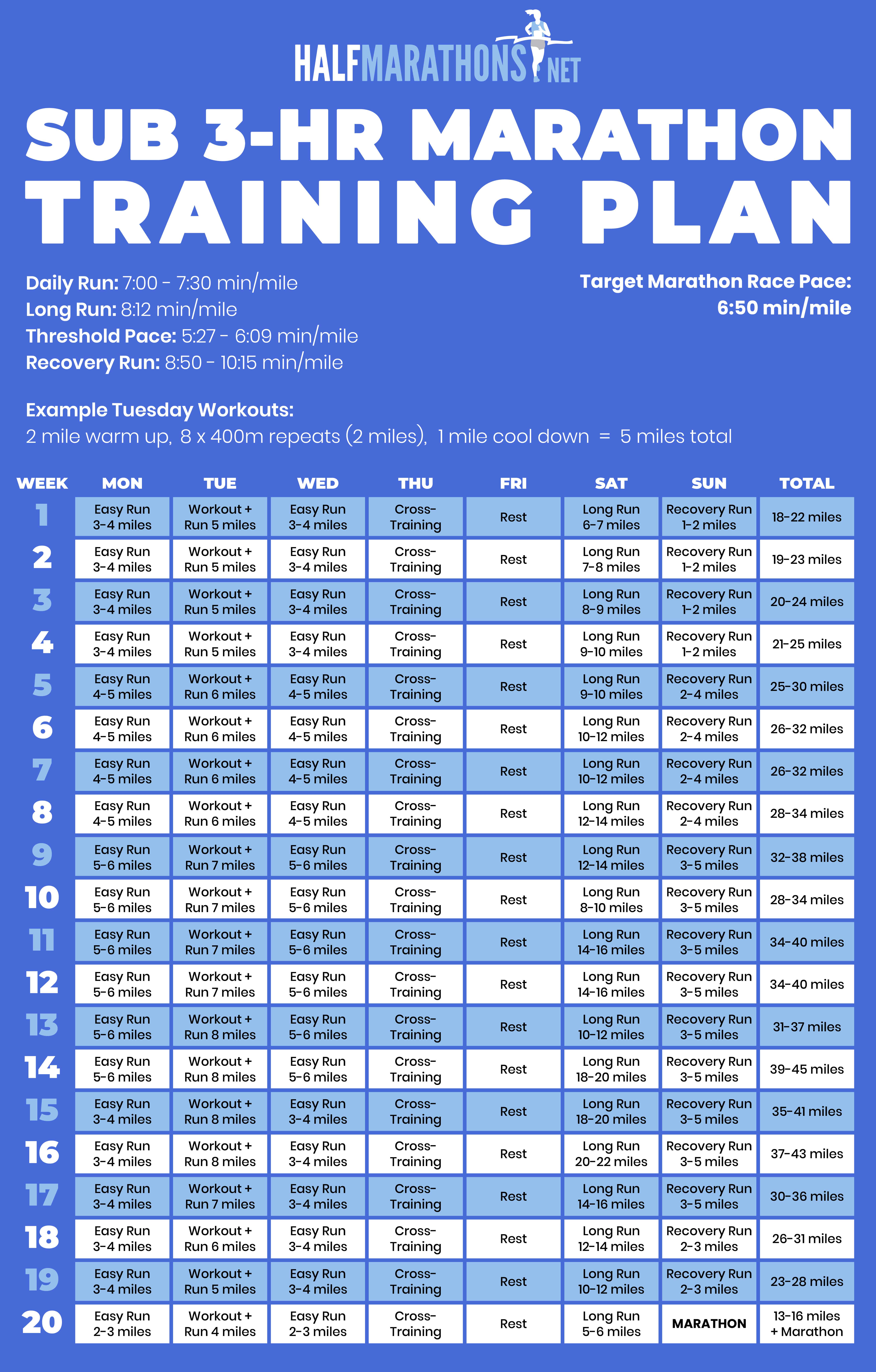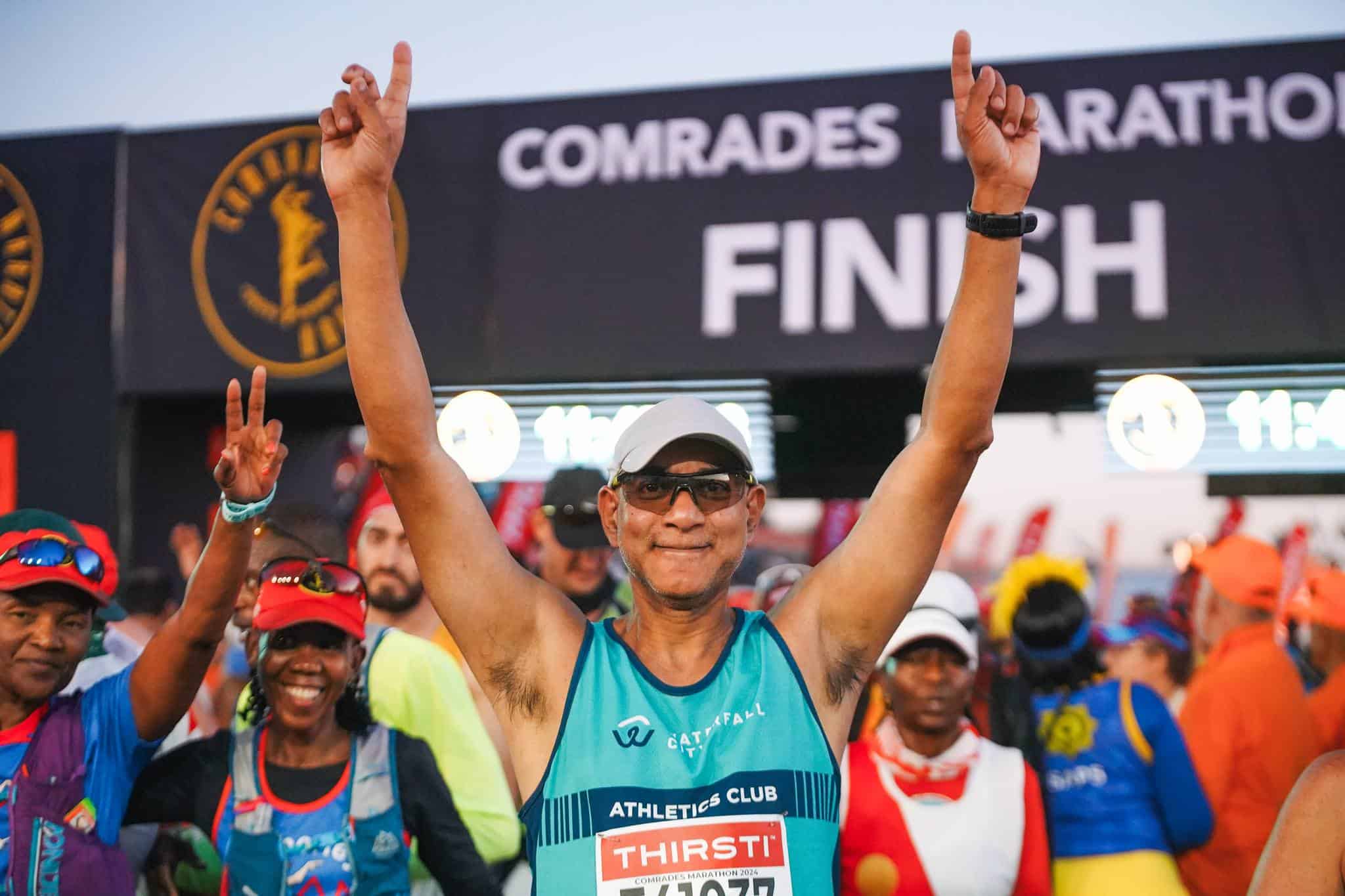Completing a marathon, no matter how long it takes, is a massive accomplishment. But some runners are not satisfied to stop there: Finishing times start to enter the equation, and, as they train to run faster and break 5 hours, then 4 hours, it’s the 3 hour marathon pace that often becomes a hard-to-reach running goal.
Having run nine marathons myself — including two U.S. Olympic Marathon Trials — with a personal best of 2:30, I understand the allure of breaking the 3-hour mark. Moreover, as both a runner and a running coach, I understand the preparation necessary to get you over that line.
To run a 3 hour marathon, a good running pace needs to be 6:50 per mile for 26.2 miles (or faster). This is not a realistic goal for everyone — Outside reports that only about 4% of marathon finishers break 3 hours. But if you’re willing to put in the time and effort, able to handle the training required, and fortunate enough to stay healthy during the build-up, a 3-hour marathon pace may be a goal worth shooting for. Here’s how you train for it.

Why Aim for a Sub-3 Pace?
Even if you are capable of joining the prestigious sub-3 club, it’s fair to ask why it may be worth the effort over months, if not years.
First, there’s an acute sense of accomplishment that comes from breaking the 3-hour mark. Since marathon running is primarily a sport in which you’re competing with yourself and pushing your body to the brink, this is an exciting running goal to work towards.
Second, if you’ve caught the Boston Marathon bug, running at a 3 hours marathon pace may be your ticket into the iconic race. Men between 18 and 34, who comprise a large swath of marathon runners, must break 3 hours in order to qualify for the Boston Marathon. Partially as a result of that, the sub-3 race has become an increasingly popular objective.
Who Should Try It?
Like we mentioned, only about 4% of marathon finishers cross the line in under 3 hours. With over one million people finishing full marathons each year, that means roughly 40,000 people finish with a 2 at the front of their time.
Marathon running, over time, is all about repeatedly setting new goals for yourself. For a fraction of runners, a 3 hour marathon pace might be an appropriate goal, like if you’re:
- Coming from competitive running backgrounds (such as collegiate track and field and/or cross country)
- Are already training at a high level for other distances (such as the 5K, 10K, and half marathon)
- Have run a marathon within striking distance of 3 hours (give or take 3:15)
If this sounds like you, it may be time to start targeting the sub-3.
But if that’s not you, don’t be discouraged — many marathoners would be over their heads in the 3-hour territory. If you’re still working on:
- Simply finishing 26.2 miles
- Minimizing walk breaks, like with polarized training
- Maintaining consistent pace over the course of the race
Then you’re better off focused on these as your goal than your time. You’ll have a much more positive experience if you go in with a challenging but realistic goal.
Related: 2 weeks of free marathon training with Runna using code HALF.

How to Run a 3 Hour Marathon Pace
Most marathon training plans require between 12 weeks and 20 weeks of specific training.
You’ll want to book your race as soon as you’re ready. Then, determine your training schedule backwards from the race date.
There are four commonly agreed-upon segments of training:
1. Build Your Base
The key objective here is getting your body and mind ready for a rigorous training schedule. I recommend running 5-6 days a week for at least 4-6 months. This will help establish a good routine and prevent injury down the road.
During this phase, you’ll likely be running at least 40 miles a week, with long runs around half-marathon distance or a little longer.
2. Increasing Distance and Intensity
In phase two, you’ll be increasing your mileage as well as your pace. Importantly, your long runs will get longer, as will the volume of your hard workouts.
In between long runs, you’ll be incorporating more hard workouts like track sprints and fartlets to support your aerobic development.
3. Peak Training
When you approach peak training, you’ll be running 20+ miles on long runs. Here, you should be regularly running at or below race pace (6:50/mile).
During this phase, prepare to spend:
- At least one hour a day running
- 2:30 to 3 hours on your weekly long runs
- Time every day to promote recovery (with massage, foam rolling, ice bath, etc)
- Time every day to ensure you’re eating enough and eating solid meals for runners
- Time every day or week to incorporate mobility work and strength training
4. Tapering
The last 2-4 weeks before the race is devoted to the taper, a time dedicated to backing off training and setting yourself up to capitalize on all of the work you’ve put in. It can be tempting to second-guess yourself or try to squeeze in extra long runs or flashy workouts. But these measures are usually short-sighted and may backfire on race day.
My sweet spot when it comes to tapering seems to be around two weeks, with my longest long run occurring around three weeks from race day and my mileage decreasing shortly afterwards.

Types of Marathon Training Runs
Any good marathon training plan, especially a 3-hour marathon training plan, is comprised of the following types of training runs:
- Marathon race pace
This is exactly what it sounds like. You’re running at the 6:50 pace you’re planning to run during the marathon. This helps your body acclimate to a sustained Zone 3 effort.
At first, that pace may feel more like a sprint, but as your fitness develops over time, it will become easier to maintain this pace for extended stretches. I always know I’m ready to run a solid marathon if, towards the end of my build-up, I can maintain my goal race pace for 15-16 miles in training.
- Intervals
One of the best track workouts, interval training alternates periods of very hard running with periods of walking or easy running. It can be done on a track or with a running watch such as a Garmin or COROS.
In these training sessions, you’ll run set distances at race pace or faster, with recovery periods in between each one. One of my standard interval workouts before a marathon is eight to 10 rounds of 1 mile, running at least 30 seconds faster than goal race pace, with a slow 400 meters in between each repetition.
This type of training helps make race pace feel easier, and also offers ample opportunity to work on your power and form.
- Hill
Hill training, whether structured (such as 12 x 30-second uphill charges) or unstructured (long runs on a hilly route), are beneficial for any type of marathon. But they’re especially beneficial on races that are technically hilly. Training on hills also can make you mentally tougher, which is a necessity over 26.2 miles of hard running.
- Tempo/Progression
Tempo runs are runs shorter than race distance, at a pace faster than goal race pace.
They require extended focus while running hard and are the fundamental workouts behind how to run a faster race. In a marathon build-up, a tempo run might look like 10 miles faster than race pace (such as 6:30). It will likely take you several weeks to work up that, but that’s what training is all about!
Progression runs are similar to tempo runs, but rather than maintaining one pace over the course of the workout, you aim to get faster as you go. An example of a marathon progression run is 9 miles with:
- The first 3 miles being slightly slower than race pace
- The second 3 bring around race pace
- The last 3 being well under race pace
- Easy Runs
An common fallacy in marathon training is not hitting your hard runs hard enough — or easy runs easy enough. When it comes to easy runs, the emphasis should on effort, not pace.
These should be nice and slow, run at a conversational pace. The goal is to increase mileage and shake your legs out after a hard workout or long run.
Whatever pace feels relaxed is fine, but something around 8:00 or slower works just fine.When I’m in the thick of marathon training, the pace of my easy runs is highly variable. Some days 7:00 feels easy, while other days 8:30 feels right.
The key with these runs is listening to your body and not getting caught up in the numbers on your watch.
- Long Runs
Each week will culminate with a long run aimed to get your body and mind used to the longer distances. Some training plans incorporate hard workouts into long runs (such as 20 miles alternating 1 hard mile with 1 easy mile). Others treat long runs as just time on foot.
Either way, treat your long runs as dress rehearsals for race day in terms of what you’ll wear and how you’ll fuel, and feel your confidence rise each time you complete one. .
Many marathon plans peak with a 20-mile long run. I prefer to go up to 25 or 26 miles because my body has proven it can handle that load and still recover for more training, and because I enjoy the confidence boost I get from running at or near the distance of the race.
Sub-3 Hour Marathon Training Plan
A weekly schedule to train for that 3 hour marathon pace might look something like this:
- Monday: Easy run
- Tuesday: Speed workout (intervals or hills)
- Wednesday: Easy run
- Thursday: Tempo or progression run
- Friday: Rest day (cross train or off)
- Saturday: Long run
- Sunday: Shorter recovery run
Some plans have runners sticking to the same order every week whereas others switch things around, but the long run/rest should be consistent even if you change the other aspects.
The goal as you move through the phases of training, is to increase your mileage while decreasing your pace in workouts.
I’m a fan of building in a down week (significantly reduced volume, sometimes with an extra day off) every 3 or 4 weeks.
Download the Sub 3-Hour Training Plan

FAQs
What Should I Do to Train for a 3 Hour Marathon Besides Running?
Biking, swimming, and other low-impact forms of cross-training can help improve your cardiovascular endurance while reducing your risk for injury. If you’re injury prone, you may want to consider replacing one to two runs a week with cross-training.
What Are the Most Important Things to Do for Running a 3 Hour Marathon?
The goal in training is to get your body as prepared for long distances as possible so the actual marathon isn’t a physical shock. If you’re aiming for a goal as ambitious as a 3-hour marathon, it’s important to follow your training plan and consistently show up for your runs. Skipping or cutting runs short on a regular basis will not give you the results you want.
That said, no amount of training will matter if you get injured or burn out before race day. The key to staying healthy is getting plenty of rest. Run easy runs easy. Build in rest days. If you feel something isn’t right, rest instead of run, and seek a professional’s opinion if you can’t shake it within several days.
How to Avoid Getting Injured While Training for a 3 Hour Marathon
1. Get plenty of rest and allow your body to recover on easy runs or rest days.
2. Cross train and strength train to build supporting and stability muscles.
3. Take your nutrition and hydration seriously throughout the whole buildup. Eat enough (probably more than you think you should), eat a variety of foods, and carry around a water bottle at all times.
What Should I Do on Race Day if You’re Trying to Run a 3 Hour Marathon?
It’s also essential to ensure that you have comfortable and appropriate gear for race day, especially when it comes to marathon racing shoes. Don’t wait until the race itself to find out that your shorts rub in weird places or that your sports bra is restrictively tight.
What Is the Fastest Marathon Time Ever Run?
–
Everything featured on Half Marathon Guide is independently selected and curated. We may receive a small commission on purchases made from some of our links.





